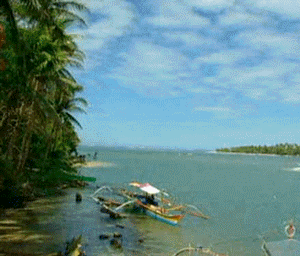Tribung Pinoy
The Philippines
Brief History
Philippine Government
The Gateway
Economic Profile
Arts & Culture
Indigenous People
Speak Filipino
Music & Song
Photo Gallery
Important Links
What's New?
Links to Philippine media
organizations, embassies & consulates,
public and private offices and organizations.
Click here
Philippine Flag
Click here
National Anthem
Click here
|
The Philippines is located off the southeast coast of Asia. It lies
between Taiwan on the north and Borneo on the south. The western
Pacific Ocean and the South China Sea border its eastern and western
limits.
The archipelago is composed of some 7,107
islands and covers a total land area of 116,220 square miles. The
islands are divided into Luzon in the north, Visayas in a central
cluster and Mindanao in the south. Quezon City, a suburb of Manila,
the premier city, is the country's capital.
The Philippines coastline stretches to 10,850
statute miles. It has many fine natural harbors and landlocked
straits. The land consists of coastal plains with many central peaks
and mountain ranges. Hong Kong is 1 hr. & 40 minutes from Manila by
jet; Singapore is three hours away; Sydney, 7-1/2 hours. It takes 17
hours to fly to Europe and 15 hours to get to the US West Coast.
The Philippines is generally
mountainous, with many single peaks and ranges. The highest mountain
is in Mindanao, Mt. Apo, about 9,600 feet high. The second highest
peak is Mt. Pulog in Luzon, which is about 8,481 feet high. The
country has a number of volcanoes, the most famous Mt. Mayon in Luzon,
reputed to be the world's most perfect cone. Taal Volcano, also in
Luzon, is unique because of its volcano-within-a volcano structure.
Taal is considered the lowest volcano in the world, its top reaching
almost the waterline of Taal Lake.
One of the architectural wonders of the
world, the Banaue rice terraces, found 250
miles north of Manila, in Banaue in the mountain provinces, was hewed
out of mountainsides by loving hands centuries ago. Time and patient
hewing at the mountains produced some 14,000 miles of terraces, or
roughly more than halfway around the world, if laid end to end. The
terraces rise about 5,000 feet above sea
level, a product of human ingenuity, for here man has pitted his wits
against nature and succeeded in turning otherwise unproductive stone
mountains into arable ledges where rice can grow.

Philippine coastal area |
The Philippines has fertile coastal plains, rolling uplands and
extensive valleys traversed by rivers. The principal rivers are
Cagayan river in northern Luzon, which is 354 kilometers long; the
Agusan and Rio Grande rivers in Mindanao; and the Agno and Pampanga
rivers in central Luzon.
The Philippine Deep is located 72 kilometers
(45 miles) off the coast of northern Mindanao and is recognized as the
world's second greatest ocean deep, with a depth of 10,802 meters
(35,400 ft).
|